In the realm of avian diversity, subtle variations in physical traits and behaviors often unveil intriguing insights into the lives of bird species. The Ash-throated Flycatcher and Brown-crested Flycatcher stand as remarkable examples of such distinctions.
From their size and plumage to behaviors and habitat preferences, these two avian species possess a host of characteristics that set them apart.
Exploring the nuances that differentiate these flycatchers not only deepens our understanding of their ecological roles but also underscores the remarkable diversity thriving within the avian world.
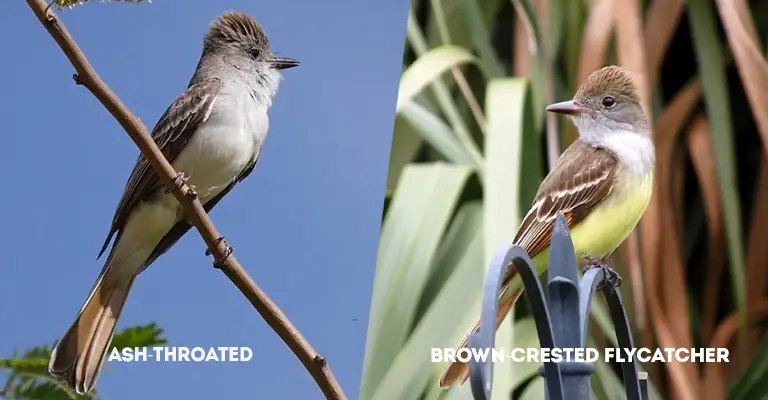
Key Differences Between Ash-throated and Brown-crested Flycatcher
The Ash-throated Flycatcher (Myiarchus cinerascens) and the Brown-crested Flycatcher (Myiarchus tyrannulus) are two similar-looking bird species found in North and Central America. While they share some similarities, there are also key differences that can help distinguish between them:
Size
- Ash-throated Flycatcher: This species is notably smaller in size compared to the Brown-crested Flycatcher. Its overall body dimensions are more compact, contributing to a slightly daintier appearance.
- Brown-crested Flycatcher: In contrast, the Brown-crested Flycatcher is larger in size. Its body is more robust and substantial, showcasing a distinct contrast in size when compared to the Ash-throated Flycatcher.
Bill Size
- Ash-throated Flycatcher: The Ash-throated Flycatcher boasts a smaller bill relative to its body size. This feature is discernible as its bill appears proportionally slender and delicate.
- Brown-crested Flycatcher: The Brown-crested Flycatcher, on the other hand, possesses a larger bill. This bill is more substantial and noticeable, standing out against its body and head.
Tail Coloration
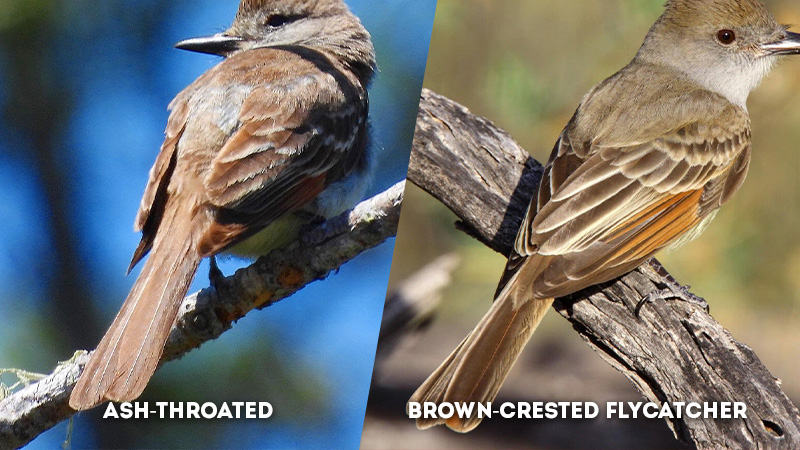
- Ash-throated Flycatcher: The Ash-throated Flycatcher displays a more subtle rufous (reddish-brown) coloration in its tail feathers.
The rufous hue, if present, tends to be less pronounced and may blend in with the overall grayish-brown color of the bird’s plumage. - Brown-crested Flycatcher: Contrasting with the Ash-throated Flycatcher, the Brown-crested Flycatcher often exhibits more noticeable rufous in its tail feathers.
This reddish-brown coloration can be striking, especially when observed in flight or during other movements.
Breast and Belly Transition
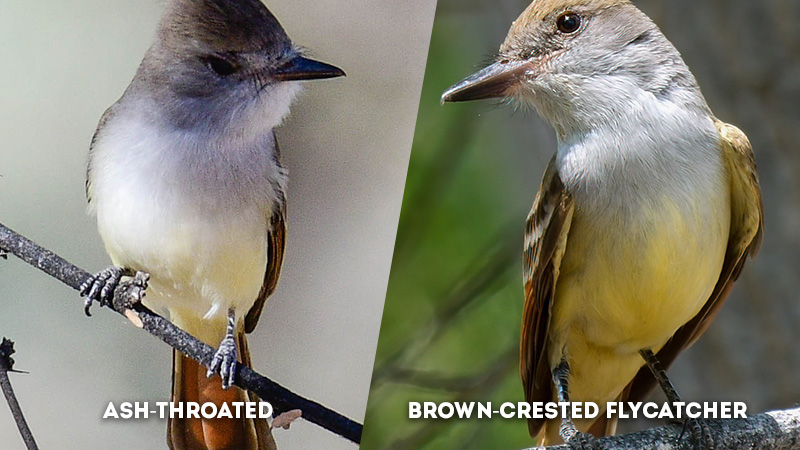
- Ash-throated Flycatcher: The transition between the gray breast and the yellow belly of the Ash-throated Flycatcher is characterized by a gradual and less distinct change in color. This creates a smoother visual gradient from the grayish upper breast to the yellowish lower belly.
- Brown-crested Flycatcher: In contrast, the Brown-crested Flycatcher showcases a more defined contrast between its gray breast and yellow belly. The demarcation between these two regions is often sharper, leading to a more striking visual separation.
Voice
- Ash-throated Flycatcher: One of the most reliable ways to differentiate between these two species is through their vocalizations.
The Ash-throated Flycatcher emits a clear, melodious song that carries a distinctive and often pleasing quality. This song can vary but generally consists of musical and whistling notes. - Brown-crested Flycatcher: The Brown-crested Flycatcher, in contrast, possesses a vocalization pattern that leans toward hoarse and scratchy calls.
These calls lack the melodiousness of the Ash-throated Flycatcher’s song and can be likened to rougher and more discordant sounds.
Habitat Preference
- Ash-throated Flycatcher: The Ash-throated Flycatcher is commonly found in open woodlands, desert scrub, and similar dry habitats. It thrives in environments with scattered trees and shrubs, often in semi-arid regions.
This species demonstrates a preference for habitats where it can perch prominently and hunt insects in mid-air. - Brown-crested Flycatcher: The Brown-crested Flycatcher tends to inhabit riparian areas, canyons, and environments with denser vegetation.
It is often found near water sources and in more lush habitats, where it can exploit the abundance of insects and nesting sites.
Geographic Range
- Ash-throated Flycatcher: The Ash-throated Flycatcher has a range that extends from the southwestern United States through Mexico and into Central America. Its distribution covers a significant portion of western North America.
- Brown-crested Flycatcher: The Brown-crested Flycatcher’s range overlaps with the Ash-throated Flycatcher in the southwestern United States, Mexico, and Central America.
It is also found in parts of the Caribbean. While there is overlap, specific geographic locations within their ranges are important for accurate identification.
Plumage
- Ash-throated Flycatcher: This species features grayish-brown upperparts and yellowish underparts. The plumage is relatively subdued, fitting its habitat preferences in drier environments.
- Brown-crested Flycatcher: The Brown-crested Flycatcher’s plumage is also characterized by grayish-brown upperparts, but it tends to have a more prominent and distinctive yellow throat. This yellow throat stands out against the grayish-brown backdrop.
Crest
- Ash-throated Flycatcher: The Ash-throated Flycatcher exhibits a short crest that is often inconspicuous and blends with its plumage. This crest is not a dominant feature of its appearance.
- Brown-crested Flycatcher: As the name suggests, the Brown-crested Flycatcher possesses a more prominent crest on its head. This crest can be noticeable and erect, especially when the bird is alert or in a state of excitement.
Eyeline
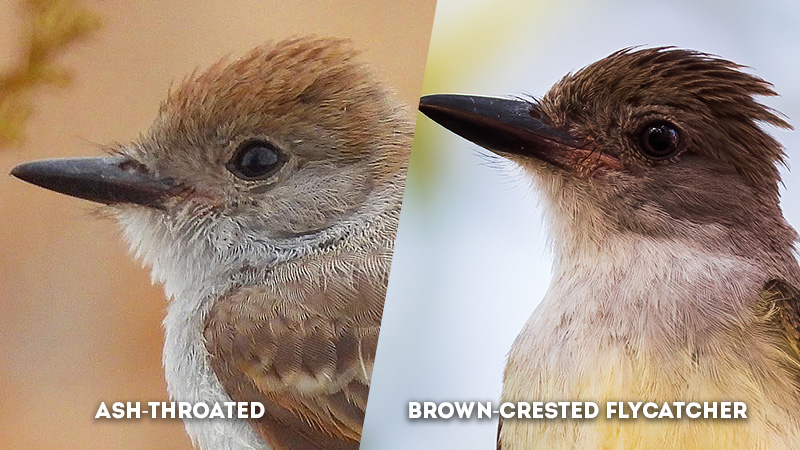
- Ash-throated Flycatcher: The Ash-throated Flycatcher typically lacks a prominent eyeline. While there might be a faint suggestion of an eyeline, it’s not a defining feature of its appearance. This contributes to a more subtle and understated facial pattern.
- Brown-crested Flycatcher: The Brown-crested Flycatcher showcases a distinct bold eyeline that extends from the base of the bill, through the eye, and towards the nape of the neck. This dark eyeline stands out against the bird’s plumage, creating a visually striking contrast on its face.
Eye Ring
- Ash-throated Flycatcher: This species generally lacks a noticeable eye ring or orbital ring around its eye. The area around the eye tends to blend with the surrounding plumage, resulting in a more cohesive facial appearance.
- Brown-crested Flycatcher: The Brown-crested Flycatcher is characterized by a prominent white eye ring encircling its eye. This feature creates a striking contrast against its dark eye and adds to the overall eye-catching appearance of the bird.
Throat Color
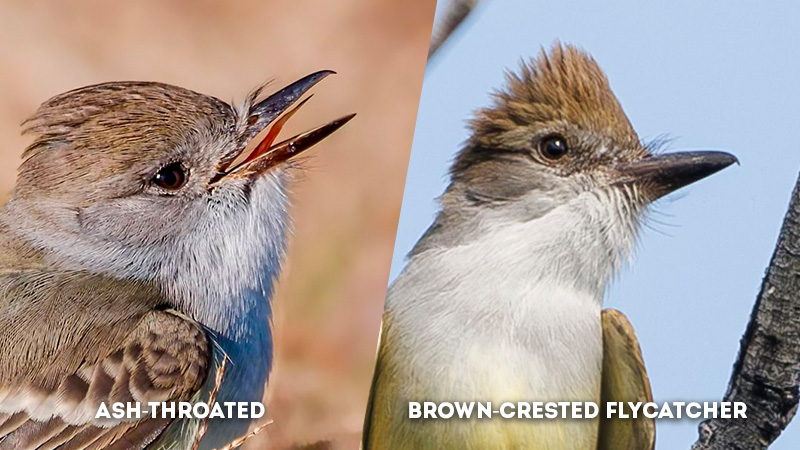
- Ash-throated Flycatcher: The throat color of the Ash-throated Flycatcher is typically pale and consistent with the rest of its underparts. This muted throat color contributes to its overall subdued appearance.
- Brown-crested Flycatcher: The Brown-crested Flycatcher boasts a vivid yellow throat that stands out prominently against its grayish-brown upper breast. This splash of color adds vibrancy to its plumage and is an important identifier.
Wingbars
- Ash-throated Flycatcher: This species displays pale wingbars that are visible on its wings. These wingbars are relatively subtle and contribute to the bird’s overall subdued and blended appearance.
- Brown-crested Flycatcher: The Brown-crested Flycatcher’s wingbars are also pale but can be more noticeable due to the contrast against its darker plumage. These wingbars are a distinctive feature when observing the bird in flight or perched.
Undertail Coverts
- Ash-throated Flycatcher: The undertail coverts of the Ash-throated Flycatcher are characterized by a cinnamon coloration. These feathers, located under the tail, can be seen when the bird is in flight or perched.
- Brown-crested Flycatcher: In contrast, the undertail coverts of the Brown-crested Flycatcher are white. This feature provides a visual contrast against the rest of its plumage, particularly when observing the bird from behind.
Primary Projection
- Ash-throated Flycatcher: The Ash-throated Flycatcher displays a moderately long primary projection. This means that the primary flight feathers extend beyond the tertial feathers (the feathers on the inner edge of the wing). The extension is noticeable but not excessively long.
- Brown-crested Flycatcher: In contrast, the Brown-crested Flycatcher showcases a longer primary projection. Its primary flight feathers extend notably beyond the tertials, creating a more pronounced and extended appearance when the bird is in flight.
Tail Shape
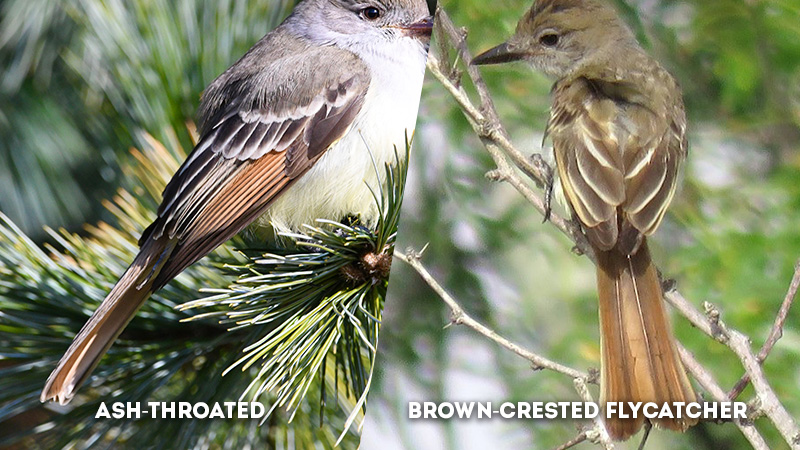
- Ash-throated Flycatcher: The tail of the Ash-throated Flycatcher is slightly forked, with the outermost feathers on each side extending slightly beyond the central tail feathers. This fork is not deeply pronounced but is visible upon closer inspection.
- Brown-crested Flycatcher: The Brown-crested Flycatcher’s tail is more deeply forked than that of the Ash-throated Flycatcher. The outer tail feathers extend significantly farther outward, giving the tail a more distinct and noticeable V-shape.
Tail Length
- Ash-throated Flycatcher: The tail of the Ash-throated Flycatcher is of moderate length, proportional to its body size. It contributes to the bird’s balanced and agile appearance during flight and perching.
- Brown-crested Flycatcher: The Brown-crested Flycatcher’s tail is notably longer in comparison. This elongated tail adds to the bird’s overall length, creating a more elongated silhouette in flight and when at rest.
Behavior
- Ash-throated Flycatcher: The Ash-throated Flycatcher is known for its conspicuous perching behavior. It often perches in open areas where it can be easily seen, and it hovers in the air while hunting for insects. This hovering behavior is a distinctive characteristic of this species.
- Brown-crested Flycatcher: The Brown-crested Flycatcher, while also perching to hunt, tends to hover less frequently than the Ash-throated Flycatcher. Its behavior is more active, involving more direct flights and maneuvers while chasing insects.
Nesting
- Ash-throated Flycatcher: The Ash-throated Flycatcher typically builds its nests in natural tree cavities, old woodpecker holes, or man-made structures such as nest boxes. It lines its nest with soft materials such as feathers, fur, and grass.
- Brown-crested Flycatcher: The Brown-crested Flycatcher also utilizes tree cavities and old woodpecker holes for nesting. However, it’s known for incorporating snake skins into its nest construction. This behavior is unique to this species and serves as a distinctive nesting habit.
Migration
- Ash-throated Flycatcher: Some populations of Ash-throated Flycatchers are migratory, particularly those in northern parts of their range. They undertake seasonal migrations to southern regions for the winter, following the availability of insect prey.
- Brown-crested Flycatcher: Similar to the Ash-throated Flycatcher, the Brown-crested Flycatcher also exhibits migration behavior. Some populations undertake migrations to warmer areas during the colder months, ensuring a consistent food supply.
Ash-throated vs. Brown-crested Flycatcher: Comparison Table
| Feature | Ash-throated Flycatcher | Brown-crested Flycatcher |
|---|---|---|
| Size | Slightly smaller | Larger |
| Bill Size | Smaller bill | Larger bill |
| Tail Coloration | Less rufous in tail | More noticeable rufous in tail |
| Breast and Belly Transition | Less distinct transition | More distinct contrast |
| Voice | Clear, melodious song | Hoarse, scratchy calls |
| Habitat Preference | Open woodlands, desert scrub | Riparian areas, canyons |
| Geographic Range | Overlapping, specific range important | Overlapping, specific range important |
| Plumage | Grayish-brown upperparts | Grayish-brown upperparts |
| Yellowish underparts | Yellowish underparts | |
| Crest | Short crest | Prominent crest |
| Eyeline | Absent or faint eyeline | Bold eyeline |
| Eye Ring | Absent or inconspicuous | Prominent eye ring |
| Throat Color | Pale throat | Yellow throat |
| Wingbars | Pale wingbars | Pale wingbars |
| Undertail Coverts | Cinnamon undertail coverts | White undertail coverts |
| Primary Projection | Moderately long | Long |
| Tail Shape | Slightly forked | More deeply forked |
| Tail Length | Moderate length | Longer tail |
| Behavior | Perches conspicuously, hovers while hunting | Hovers less, more active in hunting |
| Nesting | Nests in tree cavities | Nests in tree cavities |
| Migration | Some migrate south for winter | Some migrate south for winter |
Frequently Asked Questions
Both species use tree cavities for nesting, but the Brown-crested Flycatcher is known for incorporating snake skins into its nest construction, which is a unique and distinguishing behavior.
The undertail covert coloration differs, with the Ash-throated Flycatcher having cinnamon undertail coverts and the Brown-crested Flycatcher featuring white ones. This subtle difference can aid birdwatchers in identification, particularly when observing the birds in flight or perched from behind.
The Ash-throated Flycatcher thrives in open woodlands and desert scrub, while the Brown-crested Flycatcher prefers riparian areas. These preferences influence their behaviors and hunting strategies, with the Ash-throated Flycatcher’s conspicuous perching and hovering behavior suited for open spaces and the Brown-crested Flycatcher’s more direct flight behavior fitting its denser habitat.
The eyeline and eye ring are facial features that aid in identification. The absence of a noticeable eyeline and eye ring in the Ash-throated Flycatcher creates a more subtle facial appearance, while the bold eyeline and white eye ring of the Brown-crested Flycatcher add to its striking facial contrast.
The primary projection, or the extension of primary flight feathers beyond the tertials, influences flight maneuverability. The Ash-throated Flycatcher’s moderately long primary projection strikes a balance between agility and efficiency, while the longer primary projection of the Brown-crested Flycatcher enhances its aerial agility and complex flight behaviors.
To Recap
In delving into the myriad distinctions between the Ash-throated Flycatcher and the Brown-crested Flycatcher, we uncover a world where even the smallest details contribute to their uniqueness.
Through differences in vocalizations, plumage, nesting habits, and more, these avian species carve out niches within their ecosystems.
The meticulous study of such variations not only enriches our appreciation for the intricacies of nature but also underscores the importance of preserving these diverse habitats that support a plethora of remarkable avian life.
As we marvel at their individuality, we are reminded of the vast tapestry of life that enriches our world.